We sent a balloon into space — and an epic scavenger hunt ensued
This is the story of an amateur space-balloon launch that became a success—and the landing that was a disaster.
It’s a long story, but a good one. It begins with an international scavenger hunt, four tech companies, and a government agency—and ends with a teenager swaying 60 feet in the air. It involves technology, science, nature, emotion, and 36 hours in a minivan. You’ll read about bows and arrows, drones, a swimming-pool skimmer, and a cast-iron hook.
And maybe, just maybe, you’ll come away with a new appreciation for what they do at NASA. Or a great idea for your kid’s next science fair. Or at least some insight into the thermal properties of duct tape.
Chapter 1: The backstory
My daughter Tia, who’s 17, entered something called the Greatest International Scavenger Hunt the World Has Ever Seen (GISHWHES). According to the Guinness Book, it’s the world’s biggest scavenger hunt; this year, over 30,000 people competed. The entry fees fund a charity.
Teams of 15 have one week to complete a list of 200 difficult tasks, ranging from “Wearing formal attire, milk a cow in a well-appointed living room” to “Write a smartphone app that dials an old rotary-dial telephone.”
No team has ever attained everything on the list.
The toughest item on this year’s list: You had to get a child to write a letter to the universe—and then launch the letter into space. Video proof of your launch had to be submitted by September 5, 2016.
Alas, both NASA and SpaceX declined our requests to collaborate. (Shocker.)
So my enterprising daughter found a British company called SentIntoSpace.com. They, and similar companies in the US, specialize in equipping schools, hobbyists, marketers, and filmmakers with near-space helium balloon kits—everything they need to send small payloads into near space. Not quite into orbit, but high enough to capture images like this:

I offered my services as GoPro tech guy, and I invited Yahoo’s video crew to film the entire process.
Project Letter to the Universe was under way!

Chapter 2: The equipment
Amazingly, the SentIntoSpace people offered to donate a balloon kit to Tia’s educational/charitable/competitive cause. Their standard kit (normally $275) includes these items:
A huge latex balloon, about 10 feet tall when inflated. There’s also a drop cloth to protect the balloon from puncture and a clear plastic hose for connecting the helium tank.
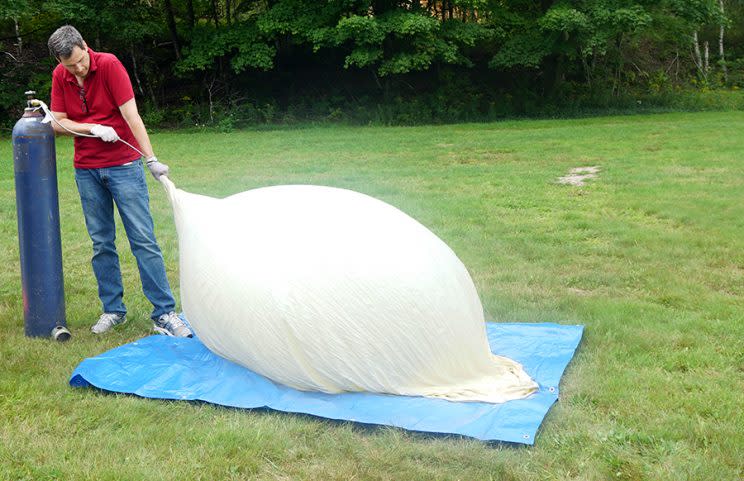
A white Styrofoam “payload box.” It’s Styrofoam because (a) it’s very cold in space, and you want to insulate your cameras and batteries, and (b) the box floats if it lands in water.

A bright orange parachute, with the necessary cords to attach it to the balloon (above it) and the payload box (below it).

A radar reflector. This shiny blue foil cardboard contraption shows up on aircraft radar—a legal requirement in the US. (We were also instructed to phone the FAA and get a NOTAM—Notice to Airmen. We provided the details of our proposed flight; the FAA rep gave us permission over the phone, quickly and helpfully.)
A location tracker. There are various ways to track your balloon once you’ve launched it. One tracker type uses cellular service, so it’s cheap and small, but won’t help you if the balloon lands out of the cellular coverage area. Another kind, the SPOT Gen3 tracker we used ($170), communicates via satellites. It’s bigger and bulkier, but it works anywhere in the world. (It ordinarily requires a $100/year subscription; it’s a favorite of hikers and mountaineers who need to be in touch with loved ones back home.)

A few additional items are not included in the SentIntoSpace kit:
Cameras. You wouldn’t do a space launch without some way to take pictures or videos, would you? GoPro (GPRO) loaned us two Hero4 Black cameras for this project.
Extended batteries. A standard GoPro battery lasts for only about two hours of continuous recording. That’s a problem for a space balloonist—first, because a typical flight takes 3 hours, and second, because in the extreme cold of the outer atmosphere (negative 75 degrees Fahrenheit), battery life gets cut in half. I asked DigiPower if they’d be willing to loan us a couple of their ReFuel battery packs for GoPros, available in 6-hour, 12-hour, and 24-hour (!!!) models; they kindly agreed. (We used the 12-hour models, just to be safe.) The ReFuel battery snaps ingeniously onto the back of a GoPro’s waterproof case.

Helium. SentIntoSpace doesn’t send you a huge heavy helium tank. You have to find some local supplier of that—a party store or, in our case, Hocon Industrial Gas in Bridgeport, CT. Bless their hearts: Fascinated by our project, they gave us a discount.
A fish scale. It’s important to fill your balloon with the right amount of helium. Too little, and the thing will drift too far across the country; too much, and the payload will swing wildly, ruining your footage and maybe even popping the balloon. So you’re supposed to weigh the helium as you fill the balloon—measure its upward force—by hooking it to a fish scale. (Yes, helium weighs something! Just less than regular air.)
Following the tutorial videos on SentIntoSpace’s website, Tia carved out sockets in the Styrofoam box for the two GoPros. She carved another pocket in the box’s lid to hold the SPOT tracker, which works only when it’s facing upward.

She also bent a coat hanger to hold the child’s letter in view of GoPro 1 for the entire flight. Later, we added a similar holder in front of GoPro 2 for a little Yahoo flag.
Chapter 3: The math
Here’s what happens when you launch a balloon into space. At first, it rises rapidly, about 5 meters (16 feet) per second. Over the course of an hour, it flies out of sight, through the cloud layer, and way, way up into the sky.
As the altitude increases, the air pressure drops, and the balloon expands. Eventually, it bursts. At that point, what’s left—the payload box and the parachute—begin falling back to earth.
The most difficult and educational part of a balloon launch is calculating where the damn thing is going to land. There’s not much point in launching a space balloon if you don’t get it back, right? The whole object is to capture supercool space videos that you can post on Facebook to make your rivals jealous.
You can’t fool around with these calculations. You don’t want the balloon to land in the ocean, where you’ll never see it again. You don’t want it to land in a populated area, where it might hit someone (or, worse, where someone might steal your GoPros). And you don’t want it to come down in a forest, where you’ll never be able to get it out of the trees.
You definitely don’t want it to come down in a forest.
Fortunately, you have more control over the balloon’s path than you might think. SentIntoSpace offers this calculator, where you plug in the balloon size, the weight of your payload, and the desired ascent rate. The calculator tells you how high the balloon will be when it pops. In our case, that would be 35,000 meters—about 22 miles above the earth. (For reference, airplanes fly at about 7 miles up.)
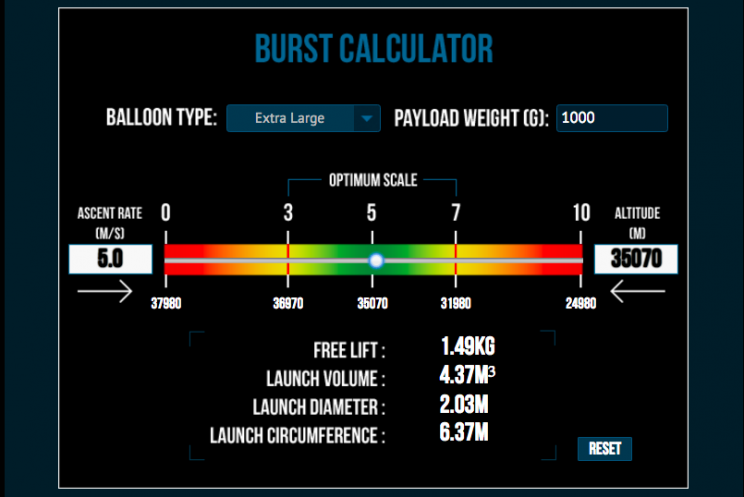
Next, you visit this calculator, which gets hardcore. Here, you specify where you’re starting (latitude, longitude, and altitude); the date and time of your launch; the desired ascent rate; and the burst altitude you’ve calculated. By stirring in the latest wind and weather information, this calculator predicts where your balloon will come down.

We live in Connecticut, which is 60% forest and has an ocean on one side. We really needed this thing to come down in some open, unpopulated area—like fields. After hours on Google Earth, I found an 80-square-mile patch of farmland that would make a perfect landing site.

Unfortunately, the prediction calculator doesn’t let you work backwards. You can’t say, “We want to land here—please tell us where to start.” All you can do is choose a launch location, run the prediction, see where it lands; adjust the launch location, run the prediction again; and so on, until it looks like the balloon will land in a good spot.
Eventually, we found an ideal launch location: the Catskill Fly Fishing Center and Museum in Livingston Manor, NY. We liked it for three reasons: It has a huge open grassy yard; launching there would put our balloon down in the middle of farm country; and who doesn’t love a nice fly-fishing museum?
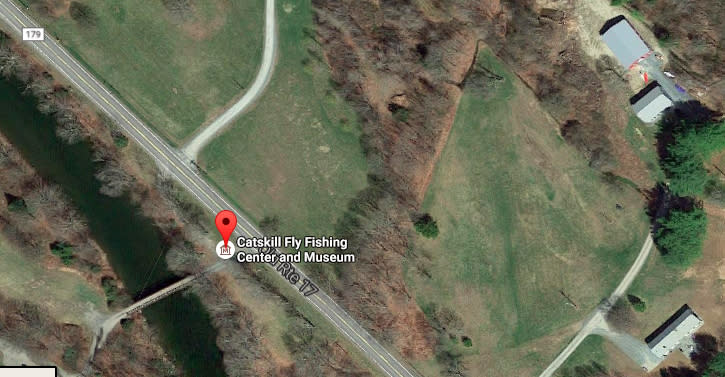
So early on the morning of August 31, we drove 2.5 hours into upstate New York. The group included team Pogue (Tia, my assistant Jan, and me); the Yahoo video crew; and Brandon Malin. At age 13, he’s our town’s best-known drone pilot. He and his mom agreed to join us in hopes of getting some great aerial footage of the launch.
Chapter 4: Launch day
We didn’t get much sleep the night before liftoff. We went over SentIntoSpace’s checklists about a thousand times. There are a lot of things that can go wrong—and you get only one shot at success.
On launch day, we were human stressballs. We had never run the GoPros for three hours at minus 75 degrees. We had never filled a balloon with helium from a tank. We had never tested our knots to see if they could withstand the violence of near-space winds. We had never used the SPOT tracker. We had never tested the accuracy of the landing-site predictor.
And, believe it or not, we had never used a fish scale to weigh helium.
We arrived at the fly-fishing museum at 10 a.m., intending to let the balloon go at about 11 a.m. It didn’t quite work out that way.
Throughout the prep process, we had been obsessively weighing our payload (box, camera, batteries, parachute, cords, radar reflector). But once we added all the duct tape, coat hangers, return-address label, and other bits, our payload weighed 150 grams more than we’d figured. We had to re-calculate the amount of helium—and to our horror, it looked like we might not have enough.
Then there was the GoPro problem. Tia had secured the cameras in their carved-out Styrofoam pockets with duct tape. But when I turned them on for testing, they both shut off after only 15 minutes!
When we pulled them out of the payload box, we knew why: They were hot enough to cook bacon. By burying the cameras and their superbatteries in foam and then sealing them in with duct tape, we had eliminated any possibility of ventilation.
In fact, at one point, I had considered that possibility; overheating cameras had been Item 723 on my list of worries. But SentIntoSpace had stressed how cold it gets in space, so I’d figured the most important thing was to keep the cameras warm. Wrong.
We needed to cool off the cameras and batteries, fast. Drone pilot Brandon suggested that we let them sit under his drone’s spinning propellers for a few minutes.
It worked like a charm. That kid’s going somewhere.
We put the GoPros back into the payload box, but this time, we used only a thin strip of duct tape to hold them in place. We hoped that there’d still be enough air cooling that way, but I wasn’t optimistic. I could easily imagine them shutting off again 10 minutes after takeoff, ruining the entire project.

A small crowd had gathered to see what we were doing. (They included the staff of the Catskill Fly Fishing Center and Museum, which had kindly OK’ed our use of their lawn.)
Incredibly, our helium tank ran out precisely as our balloon registered 3.3 kilograms of lift on the fish scale—exactly the amount we needed. The SPOT tracker was working, too; it was sending out a location ping every 10 minutes, which we could see on a map on our phones. After about 8 minutes, the GoPros were still happily recording onto their 64-gigabyte memory cards. Everything seemed good to go.
And so, at 1:36 p.m., Tia fed the balloon, parachute, and payload box into the air. We cheered. It flew upward and eastward, the payload box swinging. Within five minutes, it was out of sight in the bright white overcast sky.

Chapter 5: Tracking the payload
Space ballooning makes you hungry. We knew the flight would last about three hours, so we decided to grab lunch at a local café before getting into our chase vehicles.
As we waited for our sandwiches, Brandon checked the SPOT app on his phone. “We have a ping!” he cried.
And sure enough: In 15 minutes, our balloon had flown 8 miles. It was cruising at about 32 miles an hour!
We kept watching the app through lunch, giddy every time a new ping appeared. There was something unbelievably exciting about knowing that something you assembled, carrying your payload, was out there, drifting alone and unnoticed toward space.

Then, one hour after launch, we got a strange-looking ping over Kingston, New York: The balloon had stopped moving east. What the—?
When I consulted the predicted path, though, I realized that’s exactly what was supposed to happen—when the balloon bursts! At that point, there’s no more big helium ball to catch the wind like a sail, so the balloon’s horizontal motion stops. In fact, the predictor actually showed the package backtracking briefly before falling back into the atmospheric winds, dangling from its bright orange parachute, and continuing east.

The predictor’s prediction was dead on.
After lunch, we began driving toward the predicted landing spot in rural Connecticut. We were crazy happy. After all the worry and all the checklists, this thing was going precisely according to plan.
Chapter 6: A corner of Connecticut
At 3:35 p.m., the pings stopped coming.
That could mean that the SPOT tracker had fallen out of the box’s lid and was no longer facing upward. It could also mean the tracker had gotten so cold that it shut off.
Or it could mean that the balloon had landed. The SPOT tracker, as it turns out, produces pings only when it’s moving. If it’s been stationary for more than 10 minutes, the final ping shows where it is.
When we zoomed in, though, our spirits crashed: The payload and parachute had overshot our lovely farm fields by 12 miles. It had landed instead right smack in the middle of a dense, tall forest.

With the parachute unfurled, a web of cords, and a big shredded latex balloon, the odds of our payload box getting snagged way up in a tree were 100%.
We put the tracker’s final coordinates into Google Maps. It guided us to the closest road: an unpaved track in a particularly rugged piece of forest.
Tia and I were the first to arrive. We were worried about losing daylight, so we set out on foot into the forest to see if we could spot our balloon in a tree.
Let me tell you—it wasn’t the kind of hike you want to take your daughter on. Pricker bushes were chest-high. The terrain was steep. The day was hot and muggy, and the mosquitoes were out in force. Connecticut forests are the preferred summer home for Lyme ticks. And we weren’t dressed for bushwhacking.
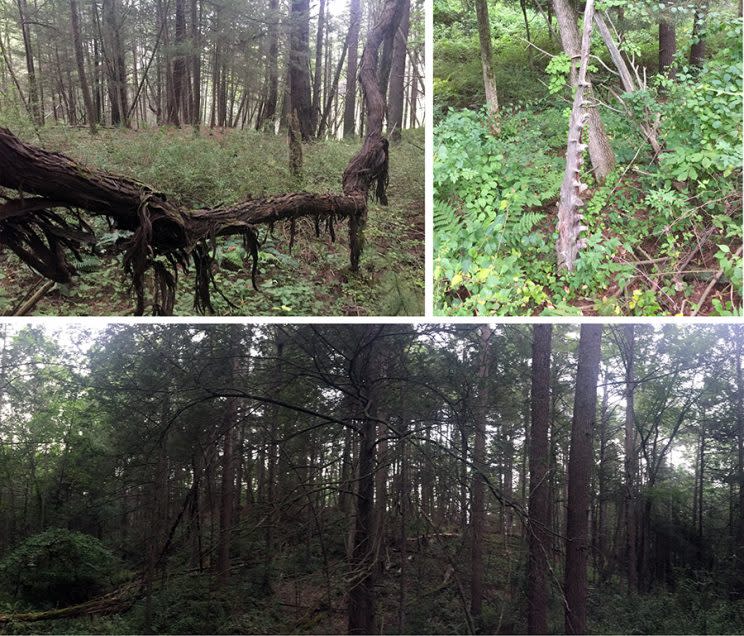
After an hour of pushing deeper into the forest, worried about the setting sun and our phones’ rapidly depleting batteries, we came to the exact spot where the balloon’s remains were supposed to be. On my phone, our blue dot in Google Maps overlapped the tracker’s final ping.

We looked up. The trees were 70 feet tall. The sky was white and the distant branches were black. Basically, we couldn’t see anything up there.
We did find one encouraging sign: About 200 feet past the supposed landing spot, we spotted a little shed in a clearing! Man, if we could have begun our quest there instead of hacking for an hour through the forest—!!
But here’s what was weird: There were no roads or trails leading to the hut. It was as though aliens had lowered it from their UFO. I didn’t know what that building was, but clearly you couldn’t drive to it.

Well, never mind that. We had no water, no food, and about 7% phone battery left. We were hot and exhausted and losing daylight—and even if we could see the payload up in the trees, what then? We had no way to reach it.
With my single dot of cellular signal, I texted the others, who were waiting at the forest’s edge. I let them know we’d be returning empty-handed.
Bumming badly, Tia and I bushwhacked our way back to the road. We were leaving behind $1,000 worth of cameras, batteries, and tracking gear. Worse, we’d never see our spectacular footage of the earth from space.
Chapter 7: Kevin
As we reached the road, my assistant Jan mentioned that she had seen a car go by. “This road must go to something,” she said. “Maybe a house. Someone who can tell us what your little hut is.”
Sure enough: At the end of the road were four houses. We chose one at random and knocked on the door. Barking; footsteps; latch opening.
He was a handsome man in his 60s, and we’d interrupted his dinner. We explained what we were doing here. He listened silently until I showed him the satellite image of that little hut.
“Oh,” he said. “That’s my spring house.”
City slickers like me don’t know what a spring house is. It’s “a small building, usually a single room, constructed over a spring. The original purpose of a springhouse was to keep the spring water clean by excluding fallen leaves, animals, etc.” (Thank you, Wikipedia.)
Turns out it was Kevin’s spring house. And we’d landed in Kevin’s forest. And we’d randomly rung Kevin’s doorbell.
“Come on,” he said, stepping off his front porch. “We can ride down there on the mule.”
We followed him out to his barn, exchanging glances. Would we all fit on a mule?
Turns out a “mule” is a gas-powered utility cart. Our man Kevin drove us through barely visible forest tracks until we arrived at the spring house.
It was practically dark now, but Kevin confirmed if Google Maps was correct, then our payload was only a couple hundred feet of forest away. “Come winter, you’ll see it no problem,” he said.
For now, it was too dark to do any more looking. But in Kevin, we had found hope.
Chapter 8: Operation FABIW
When we got home late that night, I wrote to the companies who’d contributed gear to our crazy experiment. I gave them the bad news.
They were all understanding about the loss of their equipment. Chris Rose, the founder of SentIntoSpace.com, wrote back an especially encouraging note:
I’m so pleased that despite the headache, you had yourself an adventure. That’s what these projects are all about! I wish we were over there with you; we have a team of trained climbers and equipment for just this kind of occurrence (we’ve landed in some extraordinary trees!).
I totally understand that frustration of excitedly getting to the landing zone and having to leave empty-handed! However, this only delays the ultimate reveal, where you get your hands on your results.
All the best,
Chris
For two days, our only plan was to wait for winter.
But then, on Friday, Jan texted me. “Have you tried zooming into the final SPOT dot all the way?”
What?
Of course I had zoomed in—at least far enough to see the actual trees where the payload had come to rest. But beyond that?
I opened the app and spread two fingers over and over, zooming in and in. Then I saw it. At the maximum zoom level, there wasn’t just one tracker dot—there were three of them. Eight feet apart. Ten minutes apart.

That was an incredibly exciting update. It meant that the SPOT tracker had not fallen, had not died in the cold; it had, in fact, performed flawlessly. Our balloon payload was absolutely, positively in that tree. It had spent 20 minutes sending out final pings, swaying in the breeze, telling us, “I’m here! Come get me!”
This discovery set a fire under the rest of the team. Jan and her husband John announced that they intended to return to the forest the next day, Saturday, to look for the payload.
Even more amazingly, one of Tia’s scavenger-hunt teammates, Christine Gervais, was so fired up to recover our payload that she vowed to drive over to help with the mission.
With her four kids.
From Chicago.
That’s a 14-hour drive. Now, that’s commitment.
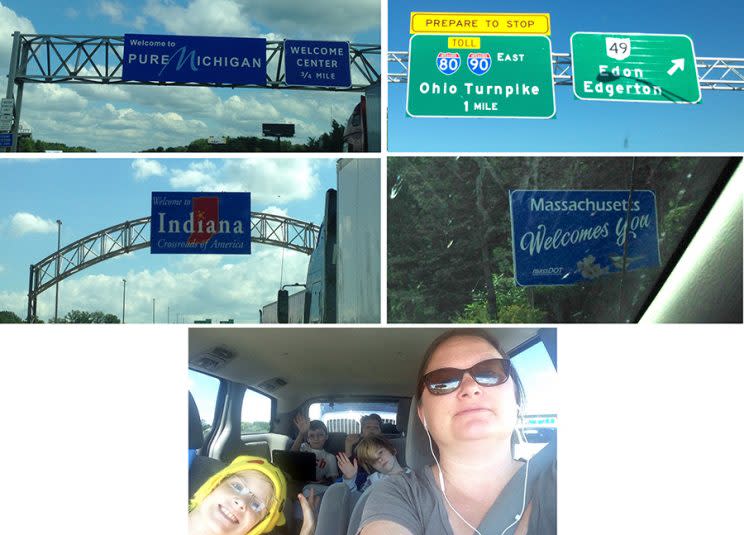
Christine and her husband Vince came equipped for a serious search-and-rescue mission, which we called Find a Balloon In the Woods (Operation FABIW). They brought professional bow-and-arrow rigs, ropes, and climbing gear. Their oldest son, 13-year-old Joshua, is an avid rock climber; as a last resort, they said, maybe he’d be willing to climb a tree.
And so, at 10 a.m. on Saturday, the team assembled once again—this time, fully loaded, armed with a carload of equipment, including a Garmin handheld GPS unit, which we expected to be more precise than Google Maps on a phone. Brandon, his mom, and his drone returned, too, so that he could help look from the air.

Even Kevin, kindly forest owner, came out to observe.
We started at the spring house and walked only 50 yards into the woods. Once the Garmin said we were at the right spot, it took Jan under a minute to spot the bright orange parachute—way, way up at the top of the trees.
From above, Brandon’s drone revealed the messy reality: The the balloon, parachute, and ropes were completely tangled in the branches. In fact, the parachute and the payload box had landed in two different trees.
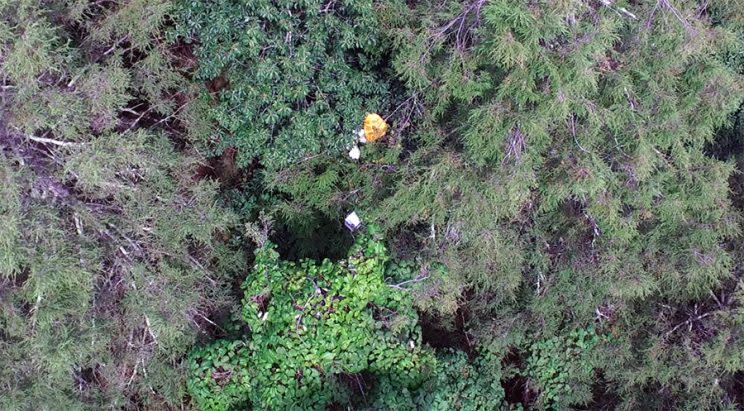
Well, we tried everything. We threw rocks at it. Vince shot arrows at it. We tied ropes around the tree and heaved it back and forth, trying to sway the box out of its clutches. Nothing worked.
After three hours of fruitless effort, we rolled out our weapon of last resort: Josh the 13-year-old. The climber. The fearless kid from Chicago.
Once his parents were satisfied with his safety rig, up he went.

He went higher, higher, and higher, until he could see the payload box—but he couldn’t reach it.
We hoisted a swimming-pool skimmer up to him—a long telescoping pole with a net at the end. Now he could swat the box, but it was still too tangled to budge.
At one point, Kevin actually suggested that we cut down the tree. (His tree, may I remind you.) Apparently, we weren’t the only ones eager for a happy ending, or at least an ending.
In the end, we didn’t have to sacrifice the tree. Kevin disappeared to his barn and returned with a hook on a long pole. Only then—after 90 minutes in the tree—did Josh manage to snag the rope. With a few powerful yanks, he dislodged the white Styrofoam box from its trap. It came tumbling down the tree trunk to the forest floor. The crowd went wild.

Chapter 9: Footage
As it turns out, none of the 956 things we had worried about came to pass. We did make it to space. We didn’t lose the payload. The GoPros never overheated; they recorded the entire journey. The ReFuel batteries drove the cameras for the entire ride, despite the cold. (In fact, they kept rolling after the landing. We wound up with many hours of boring tree video.) The tracker generated a perfect breadcrumb of location pings.

But we did get nipped by one thing we hadn’t worried about. We launched on a humid summer day—and as the air temperature dropped in flight, moisture condensed on the inside of the GoPro case and fogged it up somewhat. (If we do this again, Reddit experts suggest that we put some desiccant packets in there to absorb the moisture.)
Even so, the footage is breathtaking. You see vast expanses of New York forests, stretching for miles as the balloon ascends. You see the blanket of clouds. Eventually, the sky turns from blue to black, and you see the curvature of the earth. In some shots, as the cameras twist and swing, you see the brilliant orb of the sun peeking over the planet’s rim.

Then the cameras shake violently as the balloon explodes. You fall back to earth. You see miles of Connecticut forests below you, coming closer and closer until—boom!—you’re in a tree. And there you sit for days until an eighth grader retrieves you.

Throughout this adventure, we couldn’t believe how much support and comfort everyone gave us, from the guys at the industrial-gas company to Ellie, our contact at SentIntoSpace, who held our hands via email and answered a thousand questions. Clearly, something about a space mission inspires people, even if it’s only a teenager’s project and it’s only near space.
In short, it was a week of stress, anxiety, and emotional whiplash. I highly recommend it.
As for that child’s letter to the universe? Well, that’s the best part.

At an hour and six minutes into the video, you can see the envelope fall off its coat hanger and disappear. Only the blackness of space remains. We have no idea how that happened, or why it happened when it did.
What we do know is that our balloon hoisted the letter into space. But in the end, it delivered itself.
David Pogue is the founder of Yahoo Tech; here’s how to get his columns by email. On the Web, he’s davidpogue.com. On Twitter, he’s @pogue. On email, he’s [email protected]. He welcomes non-toxic comments in the Comments below.